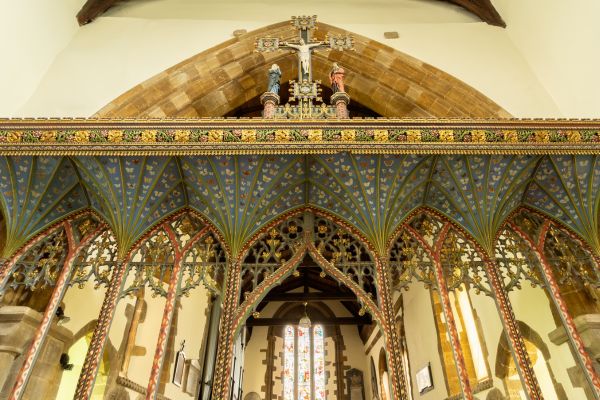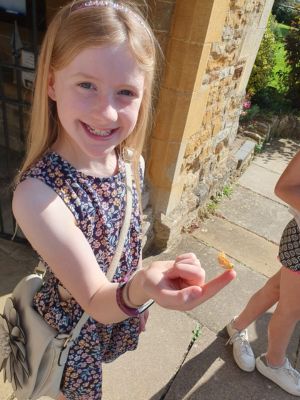Over a weekend in July, members of the Earls Barton community got together to celebrate beautiful butterflies. Themed crafts, activities and cakes were on offer along with the opportunity to take part in some butterfly spotting and recording of findings as part of the national Big Butterfly Count. Butterflies have a strong association with All Saints as they are depicted, in large numbers, on the Rood Screen mural, painted in 1935. These butterflies offer a fabulous insight into the local wildlife of the time but some are a little unfamiliar. These mysterious butterflies and the questions they raise led to the organisation of a wonderful weekend filled with butterflies and community spirit. Curate at Earls Barton, Revd Chad Chadwick explains...
 |
In 1935, when Henry Bird controversially painted an enormous mural over the medieval Rood Screen that had stood in All Saints church for hundreds of years, it is likely that he captured eight local people (representing biblical characters), each one standing amongst wildflowers and trees from the Nene Valley. Fluttering above them were hundreds of beautiful, hand-painted butterflies.
The fact that Henry was a funded lepidopterists (people who study butterflies), always made me wonder, why could I recognise so many species (painted with such skill and anatomical precision), and yet some were unfamiliar? It seemed highly unlikely that Henry decided to mix faithful representations of native species with mythical made-up additions, so there must be another reason for the unusual ‘extras’.
To solve the mystery, I contacted Dave James (the Northants County Butterfly Recorder), who also happens to love the history of church buildings and had always wanted to see the butterflies in All Saints church. The Wild@AllSaints team and Ellen Pentland (Wildlife Trust) sprung into action too, and soon an entire Butterfly-themed weekend had been organised. During the weekend, people from all over Earls Barton (and much further afield) gathered for crafts, butterfly cakes, moth ‘trapping’ and a chance to take part in the national ‘Big Butterfly Count’.
 |
Earlier in the year, the All Saints churchyard had won a Wildlife Trust Churchyard Conservation Gold Award, so we were delighted to record dozens of birds and insects in the flower-rich and rewilded, ancient natural habitat. Meanwhile, Dave and I were working hard inside the church to identify as many painted species as we could.
We recognised early-on that there was a chance that Henry Bird was painting with a sense of artistic license, perhaps even exotic butterflies from pinned specimens that were not easily identifiable. Another possibility was that Henry had one or more understudies, who were painting with less skill and accuracy, to fill the gaps with more generic butterfly shapes alongside his native species. However, whilst both of those theories could be true, there was something else going on too. We noticed a Tortoiseshell that was too big and out of shape. This was a good contender for a Large Tortoiseshell (the much larger cousin of our native, but increasingly rare Tortoiseshell butterfly). Large Tortoiseshells used to breed here but the last time breeding took place seems to be in 1949 - a few years after the screen was painted. Our conclusion - it is highly likely that when Henry Bird was painting butterflies from the Nene Valley just 89 years ago, they were not just far more numerous, but some of the species are now extinct - hence not being able to identify them!
As a result of habitat loss, intensive agricultural practices and climate change, 80% of butterflies have decreased in the last few decades. This is a deeply worrying indicator of what we are doing to the planet. However, despite the gloomy picture, I believe that God designed the natural world to bounce-back and thrive when given a chance. It is built into wildlife, just as it is built into us.
Rewilding and conservation projects show that when we care deeply, nature thrives - as it says right at the start of the bible - ‘The Lord God put man(kind) in the Garden of Eden to take care of it and to look after it’ (Genesis 2:15).
Goldcrests and a peregrin falcon (birds), Southern Hawkers and Common Darters (Dragonflies), hedgehogs and a Banded Demoiselle (Damselfly), Commas and Tortoiseshells (Butterflies)… all spotted recently in our postage-stamp sized churchyard, nature’s oasis in the middle of our village, and God’s reminder that when we care deeply, nature thrives.